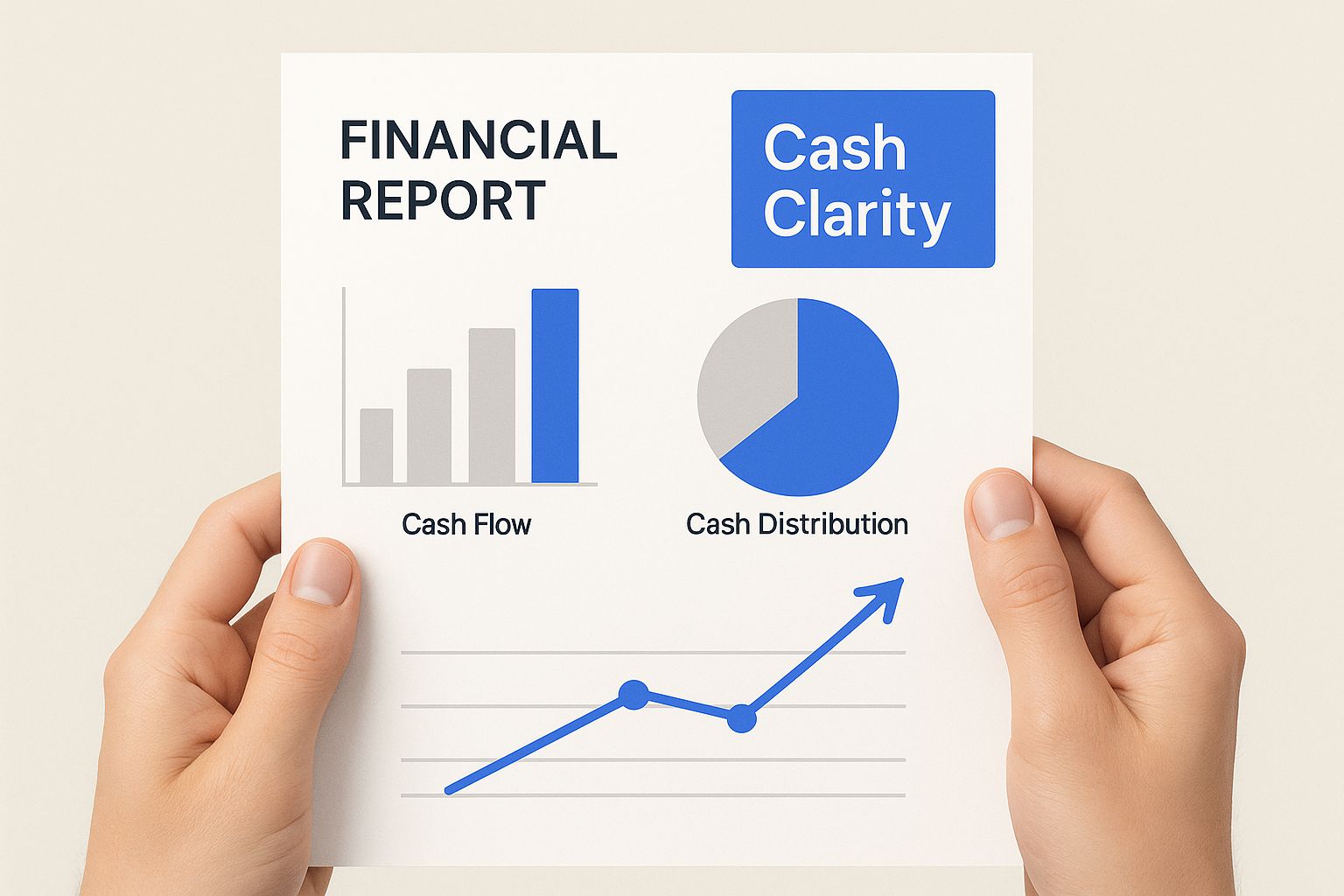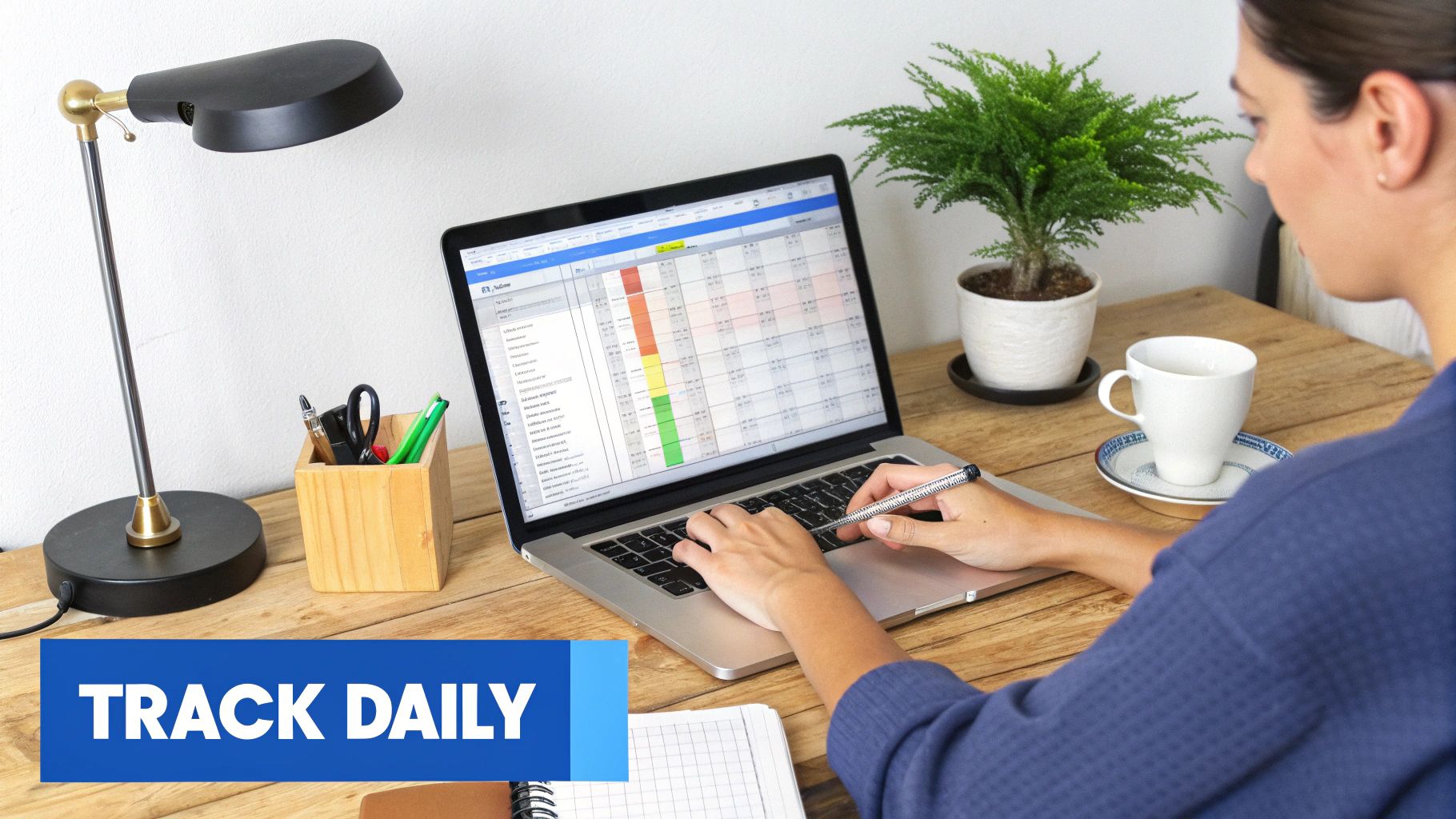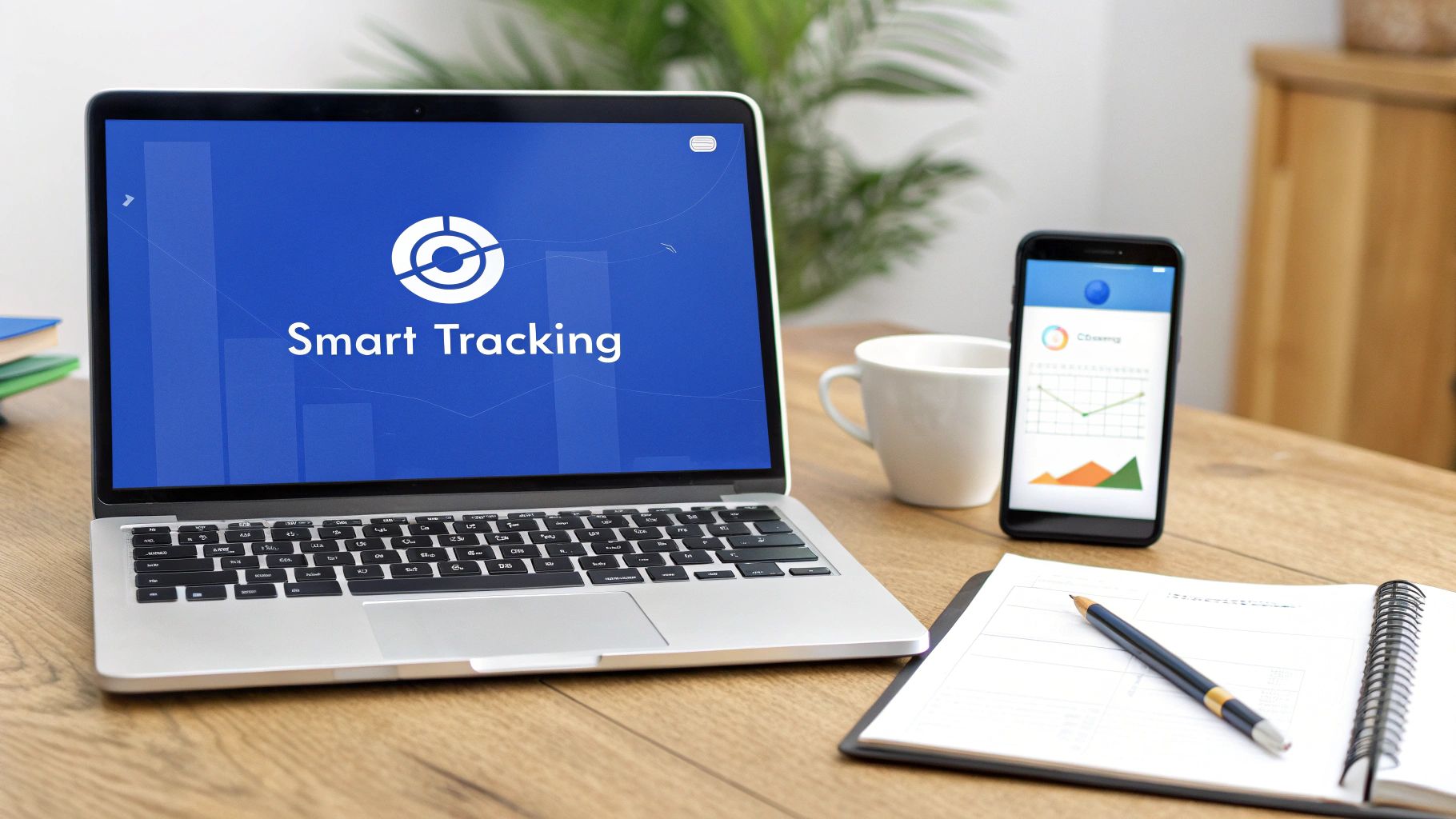Our Marketing Team at PopaDex
How to Track Cash Flow and Master Your Money

To track cash flow well, you have to watch all the money coming in and all the money going out. Simple as that. But this isn’t about putting yourself on a strict financial diet; it’s about gaining clarity and control so you can make smarter moves and build a more secure future.
Why Tracking Your Cash Flow Is a Game Changer
Let’s be honest—wrangling your money can feel completely overwhelming. So many people just avoid looking at their bank statements because they’re afraid of what they might find. This kicks off a nasty cycle of stress and guesswork.
When you fly blind, small spending leaks can easily turn into major financial drains without you ever noticing. That’s how a surprise bill suddenly tanks your entire month or why hitting a savings goal feels like trying to catch smoke.
The real power of tracking is that it turns all that ambiguity into solid, actionable information. Instead of wondering where your paycheck went, you get the actual story of your financial life, written in plain numbers.
Tracking isn’t about judging your past spending. It’s about gathering the data you need to design a better financial future for yourself, one small decision at a time.
Getting this mindset right is crucial. Once you establish a strong “why” before digging into the “how,” you’ll find the motivation to actually stick with it. The payoff becomes obvious almost immediately:
- Kill the Financial Surprises: You’ll see those recurring subscriptions and annual bills coming from a mile away, letting you plan for them instead of just reacting.
- Spot Your Spending Patterns: Finally figure out exactly where your money goes. This is how you find those easy wins—the “aha!” moments where you can cut back and redirect that cash toward your actual goals.
- Take Back Control: You stop being a passenger on your own financial journey and get firmly in the driver’s seat.
Finding the Right Cash Flow Tracking System for You
Here’s the thing: the best system for tracking your cash flow is the one you’ll actually stick with. It’s that simple. There’s no magic bullet, just what fits your life, your comfort level with tech, and how complicated your finances are.
Your options run the gamut from a simple spreadsheet to slick apps that do all the heavy lifting for you. For instance, if you’re a freelancer with income streams all over the place, the flexibility of a spreadsheet might be perfect. You can customize it to your heart’s content. On the flip side, if you’re a busy professional juggling subscriptions and regular bills, an automated app like YNAB or Mint could be a lifesaver.
This chart really nails why this matters. Getting that “Cash Clarity” from consistent tracking is what lets you make confident money moves.

Ultimately, whatever tool you pick, the goal is to turn a pile of numbers into a clear story about your financial habits.
Comparing Your Options
Let’s break down the most common methods. Each one comes with its own trade-offs in terms of cost, the time it takes to get started, and the effort needed to keep it going.
A basic spreadsheet gives you total control and doesn’t cost a dime, but it demands serious discipline and a lot of manual data entry. Budgeting apps, on the other hand, offer powerful automation and cool reports, but you might have to pay a subscription fee and get comfortable with linking your bank accounts. We actually have a great guide on the 7 best easy expense tracker options if you want to see a detailed comparison: https://popadex.com/7-best-easy-expense-tracker/
It’s also worth noting that if you have specific assets, like rental properties, you might even consider specialized accounting software to streamline things even further. The market for these tools is blowing up for a reason.
The global cash flow management market was valued at USD 0.93 billion and is projected to skyrocket to USD 7.39 billion by 2033. This just shows how many people are turning to better tech to finally get a handle on their finances.
To help you decide, I’ve put together a quick comparison of the most popular methods for tracking your cash flow.
Comparison of Cash Flow Tracking Methods
This table breaks down the pros and cons of spreadsheets, apps, and your bank’s own tools to help you find the best fit for your personal style.
| Method | Best For | Pros | Cons |
|---|---|---|---|
| Spreadsheets | DIY enthusiasts who want total control and customization. | Free, highly flexible, and excellent for learning the fundamentals of your money. | Requires consistent manual data entry and is prone to human error. |
| Budgeting Apps | Individuals seeking automation, visual reports, and goal tracking features. | Automatically categorizes transactions, provides insights, and syncs all your accounts. | Can have subscription fees and may raise privacy concerns for some users. |
| Bank Tools | People who prefer simplicity and using their existing bank’s platform. | Conveniently integrated, often free, and secure within your bank’s ecosystem. | Features are often pretty basic and lack the advanced capabilities of dedicated apps. |
Take a moment to think about what you’re most likely to use day in and day out. An amazing system that you never open is useless, while a simple notebook you update daily is priceless. Choose the path of least resistance for you.
Building Your Personal Financial Dashboard
Alright, let’s move from theory to practice and start building your personal financial command center. This isn’t about becoming a certified accountant overnight; it’s about corralling your raw financial data and making it tell a clear, simple story about your money.
First things first, you’ll need to gather your essential documents from the last month or two. Grab your bank statements, credit card bills, and recent pay stubs. While you’re at it, list out all your recurring expenses—both the fixed ones like rent and the variable ones like your power bill. I won’t lie, this initial setup is the most tedious part, but it’s the foundation for everything else. Get this right, and the rest is smooth sailing.
Create Meaningful Spending Categories
Now for the part where the magic happens: creating spending categories that actually make sense for your life. Generic labels like “Food” are just too broad to give you any real insight. You need to get more specific to understand your habits.
Try breaking down your spending into more descriptive groups. For instance:
- Groceries: This is everything you buy at the supermarket for meals you cook at home.
- Dining Out: Covers restaurants, takeout, morning coffee runs—anything you didn’t make yourself.
- Subscriptions: All those sneaky monthly charges for Netflix, Spotify, your gym membership, and so on.
- Transportation: Gas for the car, public transit passes, Uber rides, and the like.
This level of detail is what lets you see exactly where your money is going, making it way easier to spot places you could trim back. If you’re looking for more ideas, our guide on creating a personal finance dashboard has some more advanced structures you can borrow from.
A simple spreadsheet is a fantastic place to start. Here’s an example of what a basic cash flow statement can look like.

This template cleanly separates your cash inflows from your outflows and puts spending into buckets, giving you a quick snapshot of your net cash position. It’s a powerful first step to getting a real grip on your cash flow.
One common snag people hit is dealing with a variable income or those surprise expenses that love to pop up. If your paycheck fluctuates, just calculate an average from the last three to six months and use that as your baseline. It’s a solid workaround.
For irregular expenses like car repairs or holiday gifts, create a separate “sinking fund” category. Set aside a small amount of money each month specifically for these items so they don’t derail your entire financial plan when they arrive.
Making Consistent Tracking a Lifelong Habit
A perfect cash flow system is useless if you never open it. Let’s be honest, the real challenge isn’t the setup—it’s turning this into a simple, automatic routine. The goal is to make checking your finances feel as natural as checking your email.
So, how do you get there?
Start by scheduling a non-negotiable, 15-minute “money check-in” on your calendar each week. Block it out. Treat it like any other important appointment. Use this time to categorize your latest transactions and just glance at your progress. Keeping it short and consistent is the magic formula that stops it from feeling like a monumental chore.
You can also let technology do some of the heavy lifting. Set up notifications on your budgeting app to give you a heads-up when you’re getting close to a spending limit or when a large transaction hits your account. These little pings act as gentle course corrections, keeping you tuned in without having to stare at a spreadsheet all day.
Overcoming Common Hurdles
It’s completely normal to feel a jolt of anxiety when you first see your spending habits laid out in black and white. I’ve been there. But remember, this data isn’t here to judge you; it’s there to empower you. Reframe it. You’re not looking at a report card on past failures—you’re gathering intelligence for future success.
Things get even more interesting if you share finances with a partner. Getting them on board is make-or-break.
- Frame it as a team goal. Instead of pointing fingers about spending, talk about the big things you want to achieve together, like that dream vacation or finally killing off that student loan debt.
- Divide and conquer. One person can tackle categorizing transactions while the other leads the weekly check-in. Play to your strengths.
- Celebrate the small wins. Seriously. When you hit a savings target or stick to your spending plan for a month, acknowledge it. High-five. Go out for a coffee. It makes the whole process feel rewarding.
The ultimate goal here is to transform tracking from a dreaded task into an empowering habit. With a solid routine in place, staying on top of your money takes just a few minutes a week, not hours of stressful work.
Turning Your Financial Data Into Smart Decisions

After a month or two of consistently tracking your money, you’re no longer just collecting numbers. You’re sitting on a goldmine of financial intelligence. This is the moment your hard work starts to pay off, turning all that raw data into confident, smart decisions.
The first thing to do is calculate your net cash flow. It’s a simple but powerful metric.
Just take your total monthly inflows (all your income) and subtract your total monthly outflows (all your expenses). If you get a positive number, you’ve got a surplus. A negative number means you’re in a deficit. This single figure is the most honest look you’ll get at your financial health, telling you point-blank if you’re living within your means.
Uncovering Powerful Insights From Your Data
With your net cash flow in hand, it’s time to start digging deeper. Those detailed spending categories you’ve been tracking will suddenly reveal patterns you never saw before. You can finally pinpoint exactly where your money is going and uncover those pesky “spending leaks”—the small, recurring costs that bleed your account dry over time.
For instance, you might be shocked to discover your daily coffee run is costing you over $100 a month, or that a handful of forgotten streaming subscriptions are adding up to a significant drain. This is also how you start to spot seasonal trends, like a predictable spending spike around the holidays or during summer vacation, which allows you to finally get ahead of them.
Your cash flow statement is the ultimate truth-teller. It’s not a plan or a wish; it’s the factual story of your financial habits, giving you the clarity needed to build a realistic budget that actually works for you.
This whole process is exactly what successful companies do to stay afloat. A key trend, especially when the economy feels shaky, is maintaining strong liquidity by keeping a close eye on cash flow. It helps businesses ride out unexpected downturns without taking on expensive debt—a principle that works just as well for your personal finances. You can learn more about these cash management trends and see how the pros do it.
By analyzing this data, you stop reacting to financial surprises and start proactively shaping your own financial future.
How to Forecast Your Future Cash Flow
Once you’ve got a handle on tracking your past spending, it’s time to look forward. This is the real game-changer—moving from just watching your money to actively telling it where to go. Forecasting is all about using the data you’ve collected to map out your income and expenses for the next few months.
Think of it as turning your financial data into a crystal ball. This proactive approach helps you spot potential cash crunches long before they hit, giving you plenty of time to adjust your spending or find ways to bring in a little extra cash. It’s how you can confidently plan for that dream vacation or a down payment on a new car without accidentally stumbling into debt.
Getting Started with Simple Forecasting
You don’t need a finance degree for this, I promise. A basic spreadsheet is all it takes to get started.
First, list all the income you expect to receive next month. Then, pull up your spending history and list out all your anticipated expenses. Be sure to include everything—from fixed bills like rent to those variable costs like groceries and gas.
Subtract your total expected expenses from your total expected income. That final number is your forecasted net cash flow. This one simple calculation gives you an incredibly clear picture of where you’ll stand financially at the end of the month, arming you with the insight you need to make smart adjustments today.
Forecasting transforms you from a reactive spender into a proactive financial planner. It’s the difference between wondering where your money went and telling it exactly where to go.
This isn’t just a personal finance trick; it’s a core practice in modern business. Companies use real-time cash flow forecasting, often powered by AI, to make quick, data-driven decisions. For a closer look at these advanced corporate methods, you can check out the latest cash flow forecasting trends.
You can also start playing with different “what-if” scenarios to see how certain choices might affect your bottom line. For instance, what would happen if you picked up a side gig? Or how would a big, unexpected car repair mess with your savings goals? Our guide on scenario forecasting and financial planning dives deeper into these strategies. This kind of planning helps you truly understand the long-term impact of the financial choices you make every day.
Common Cash Flow Questions Answered
When you first start tracking your cash flow, a few questions always seem to come up. Let’s clear up the most common ones so you can move forward with confidence and build a system that actually sticks.
How Long Should I Track My Cash Flow Before Making Changes?
I get this one a lot. You’re eager to make changes, but jumping the gun can be a mistake.
Aim to track everything for at least one to two full months. Why so long? Because that’s enough time to see the real patterns emerge—not just the daily coffee runs, but also those sneaky quarterly bills or annual subscriptions that can throw everything off. A single weird week doesn’t give you the full story. Your goal here is to establish an honest baseline of where your money is actually going.
Once you have that data, you can build a realistic plan. This brings us to another point of confusion: how this all relates to your budget.
Think of it this way: a budget is your plan for your money, while a cash flow statement shows what actually happened. Your budget sets goals and spending limits, whereas your cash flow statement tracks the real money coming in and going out.
What Is the Difference Between a Budget and a Cash Flow Statement?
They’re two sides of the same financial coin. A budget is forward-looking—it’s you telling your money where to go. A cash flow statement is a report card on the past, showing you where it went.
You can’t create an effective budget in a vacuum. You need to analyze your cash flow first to see what’s realistic. Once you understand your past spending, you can build a budget that works with your life, not against it. One informs the other.
My Income Is Irregular. How Can I Possibly Track My Cash Flow?
If you’re a freelancer, consultant, or gig worker, tracking cash flow isn’t just possible—it’s essential. The unpredictability makes it even more critical.
The key is to find your average. Look back over the last 6-12 months and calculate your average monthly income. This number becomes your baseline for planning. Next, get ruthless about identifying your essential (fixed) expenses versus your non-essential (variable) ones.
When you have a great month, don’t upgrade your lifestyle. Instead, funnel that extra cash into a separate savings account. This becomes your buffer to cover expenses during the lean months, smoothing out those frustrating financial peaks and valleys.
Ready to see the full picture of your financial health? PopaDex helps you consolidate all your accounts into one simple dashboard, making it easier than ever to track your net worth and make smarter decisions. Get started for free and take control of your finances today.